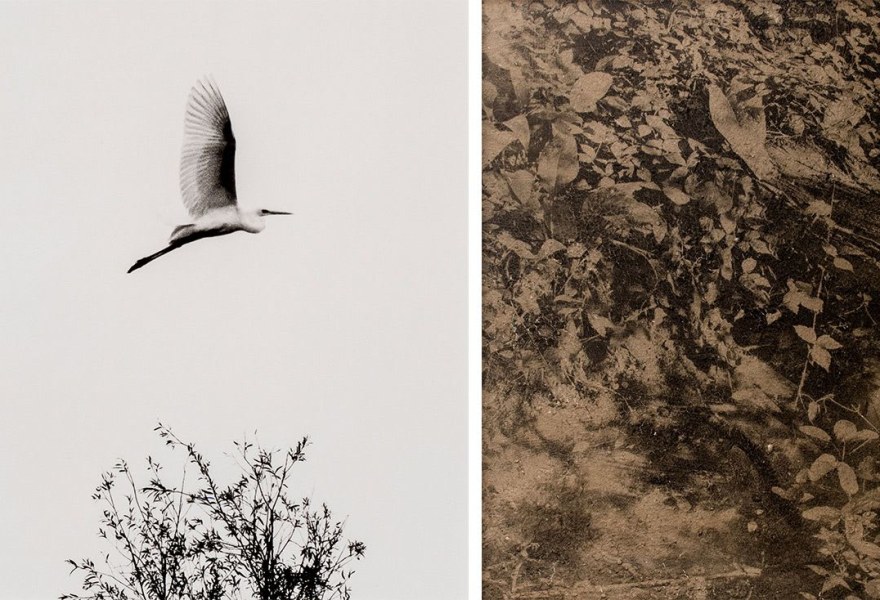06 december 2022, Flor Linckens
The materiality of the image in the work of Lucas Leffler and Hans Bol
On 17 December, Galerie Caroline O'Breen in Amsterdam opens a duo exhibition by two photographers who are both interested in the materiality of the image: Lucas Leffler and Hans Bol.
In the exhibition, the Belgian photographer Lucas Leffler shows his series "Silver Creek" (2018-2022), in which the subject and the technique seem to merge. In this artistic experiment, he questions the nature of the photographic image and at the same time looks at the history and technique of photography. For "Silver Creek", Leffler documented, deconstructed and reconstructed history.
Leffler: "Between the 1920s and 1950s, the Agfa-Gevaert factory accidentally spilled tons of silver in a stream. It was the waste of its production of photographic film. The sludge in the stream was then coloured black with silver, which earned it the name 'Zwarte gracht' (the black channel) or ‘Zilverbeek' (the silver creek). Then, in 1927, the story begins. A tool maker at the factory realised how much was lost every day. He then secretly invented a system to collect the money from the creek sludge. After draining them, he transported the dried sludge to a local metallurgical plant to extract the silver. The latter could collect around half a ton of money a year, which earned him more than his salary at the factory. He continued this small business for about 30 years. But from the 1950s, the factory installed several sewage treatment plants and was therefore able to recover the silver contained in these waters before discharging them. So there was no more money in the sludge of the stream. In addition, Agfa-Gevaert hardly produced any silver emulsions anymore. With the advent of digital, it has now switched to the medical imaging and printing industry.”

For "Silver Creek", Leffler searched through various archives, documents and newspaper clippings. He photographed the factory in question and the stream and took several soil samples — all in an effort to find traces of silver to make his own photographic emulsion. Leffler subsequently made silver gelatin and UV prints on old steel plates and turned the sludge itself into works of art in 'mud prints'. The artist is fascinated by the medium of photography, which, in his eyes, moves somewhere between science and magic. His work has previously been shown in the Swiss Elysée Museum, in FOMU (Photo Museum Antwerp) and the Center d'Art Contemporain du Luxembourg Belge, among others. His work has been collected by institutions such as the FOMU, Musée de l'Elysée, Fondation Boghossian, Contretype and the Carrefour des Arts Foundation.
In the exhibition at Galerie Caroline O'Breen, Leffler's work is presented alongside the work of Dutch photographer Hans Bol, who is known for his small-scale, mostly analogue prints, which therefore represent a certain intimacy. The photographer's images of nature are marked by silence and the passage of time. For the series "On My Doorstep", which will be shown in the exhibition, Bol was forced to draw inspiration from his immediate surroundings during the pandemic: the natural landscape of the Ooijpolder in the east of the Netherlands, where he has lived since the early 1990s. For this series, the photographer used traditional practices and materials from the 19th century, such as the platinum-palladium printing technique and the use of Toyobo plates for photo engravings. Bols also made a photo book of the same name, which was published this autumn. The title of the series and the book refers to the work of the American photographer Paul Strand.

Bol is praised for his technical skills and has been working as the permanent printer of the Nederlands Fotomuseum for over twenty years. His own work has previously been exhibited in FOAM, Fotomuseum Den Haag and Museum Beelden aan Zee, among others, and is part of the collections of museums such as the Rijksmuseum Amsterdam, Fotomuseum Den Haag, the Nederlands Fotomuseum, Museum Beelden aan Zee and FOMU in Antwerp.
